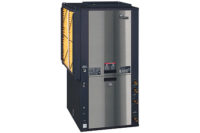
They are fan coils. Like other mechanical systems, they can consume a fair share of energy - perhaps more so than other types of equipment, because they tend not to get as much maintenance as larger products, such as chillers. And you see them everywhere, from hospitals and hotels to university dorms and individual offices.
"While institutions are generally aggressive in pursuing central plant energy efficiency, fan coils are frequently overlooked as a potential source of savings," said Charlie Putz of Carrier Corp.
"But the fact is, there may be several hundreds to thousands of fan coils in a single hospital or complex, and the fan coils employ a low-efficiency motor," typically 60 percent efficient, he said.
Part of the reason fan coils have been overlooked as a source of potential energy savings is that, short of replacing the unit with a more efficient one, there haven't been many cost-effective solutions.
"Variable-speed drive (VSD) technology that is now commonly applied to chillers, air handlers, and pumps did not reach the fan coil," Putz said, "because VSDs are expensive, and fan coils usually employ fractional horsepower motors."
Things are starting to change. Carrier Commercial Service's new fan coil VSD unit is an available retrofit on older fan coil units. The VSD technology enables the fan coil to work in parallel with, or independent of, the building control system, Putz explained.
The product has been reviewed and endorsed by the U.S. Department of Energy, and tested independently by the New York State Energy Research and Development Authority (NYSERDA), which has qualified installations for NYSERDA energy rebates. The unit is UL- and CSA-approved technology.

Adaptive Controls
The VSD's intelligent and adaptive controls give fan coil units a newfound ability to match blower speed and airflow to the actual real-time unit temperature output, the company said."Therefore, a blower motor that normally operates in an inefficient, binary mode, either off or full throttle, is modulated to deliver just enough output to meet the temperature set point requirement," said Putz.
In addition to energy savings from operating at variable speed, the fan coil delivers a more constant flow of cold or warm air. This results in a consistent comfort level, instead of the hot and cold pockets that can result from a constant-speed fan coil throttling on and off, the company pointed out.
Moreover, the unit offers decreased noise levels in the occupied space; the fan motor does not constantly modulate on and off.

The Payoff
"The economics of the fan coil VSD retrofit are compelling," said Putz. "Cooling systems represent approximately 30 percent of the electricity consumed by a typical hospital. A hospital fan coil system that has a total fan horsepower of 500 hp is actually consuming 833 hp based on the typical 60 percent fan coil motor efficiency. Older units may be running even less efficiently."Tests have shown that fan coil energy consumption can be reduced by 45 percent after a VSD retrofit, he continued, and contribute to chiller water and hot-water system efficiencies.
A hospital with 500 fan coils, paying 10 cents/kWh, could save up to $87,000 per year by having the fan coil VSD retrofitted onto existing units, with a payback of 1.7 years and a return-on-investment (ROI) of 58 percent, Putz said.
"In addition to the financial operating cost benefit to an owner, there is also a significant environmental benefit due to decreased greenhouse gases produced in some electricity generation," he added.
"Using a value of 0.5 kg/kWh, this hospital would reduce CO2 generation annually by 438,999 kg by using fan coil VSDs.
"Facility engineers and operating officers who thought the low-hanging fruit in the energy conservation equation was gone now have another tool to drive down electricity consumption," he concluded.
For more information, contact Charlie Putz at charlie.putz@carrier.utc.com, or visit commercialhvacservice.carrier.com; click on "Request Service Information" and fill out the online request.
Publication date: 11/07/2005





